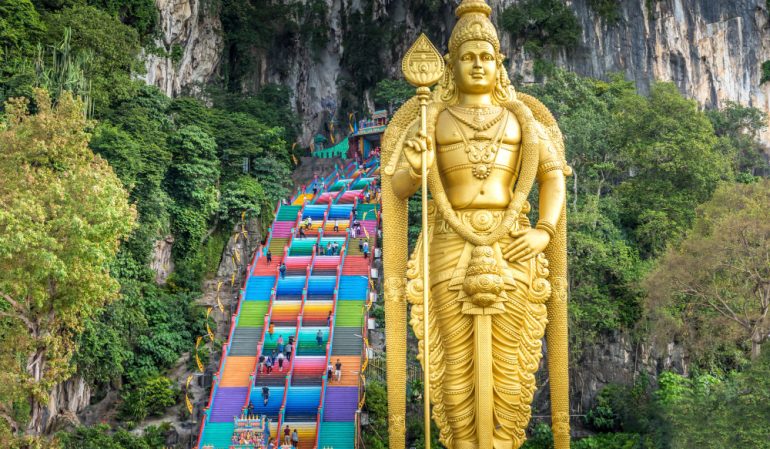Reach us
Blog

19
Apr 2024
Batu Caves – Complex Of Limestone Grottoes In Peninsular Malaysia
Batu Caves is a limestone hill that has a series of caves. It takes its name from the Malay word batu, meaning ‘rock’. The hill was originally known as Kapal Tanggang from the legend of Si Tanggang. The caves are one of the country’s biggest tourist attractions and are a place of pilgrimage for Tamil Hindus. They are named for the Sungai Batu (Batu River), which flows nearby, and are located 7 miles (13 km) north of Kuala Lumpur, the capital of Malaysia.
The Batu Caves are a series of caves among limestone hills in the district of Gombak, to the north of Kuala Lumpur, and they combine an interesting natural landscape with a major place of worship and some striking sights. While the hills are considerable and quite scenic, what makes them special is that they’re home to one of the largest and most popular Hindu shrines in the world outside of India. But there wasn’t always a shrine in the caves, and for quite some time it was used by indigenous locals and Chinese settlers to collect bat guano. Things changed, however, when the American Naturalist William Hornaday made the caves known to the international community in 1878.A little more than a decade later, they caught the attention of K. Thamboosamy Pillay, a leader of the Tamil Hindu community in Malaysia. In 1891, he had a shrine built to the Hindu god Lord Murugan within the largest of the caves, and the next year, the Hindu festival of Thaipusam was celebrated at the site. To this day pilgrims still come to the Batu Caves for the festival.
The first thing we notice when approaching the Batu Caves are the stairs with 272 steps leading up to the caves. They used to be just grey, but recently they have been transformed into one of the most colourful sights we have ever seen. All the colours of the rainbow are represented, some hate it, some love it. We simply loved it and thought they fit perfectly with the colourful religion that the Hinduism is. And of course, the provide some excellent photo opportunities.
The steps are filled with monkeys. They are everywhere. Again, they provide excellent photos, and it is fun to watch them. But some tourists feed them, try to take selfies with them and or even touch them. Something we strongly advised our kids not to do, as monkeys are still animals and can be quite aggressive or steal your food or belongings. They make climbing the stairs an even bigger attraction, in both good and bad ways. Next to the stairs is a huge golden statue of 42,7 metres / 140 feet high. The statue represents Murugan, which is a Hindu deity. It is the tallest statue of Malaysia and also the second tallest statue of a Hindu deity in the world. It stands proudly since 2006 next to the steps leading up to the sanctuary. There are actually 4 caves which are the Temple Cave, Dark Cave, Cave Villa and Ramayana Cave.
Temple Cave
Once you have conquered the stairs, you reach the biggest cave, which is the Temple Cave or Cathedral Cave with its 100 metres / 328 feet high ceiling. Inside there are a few Hindu shrines or temples, with their pujari (Hindu priests) blessing the visitors. Even we and our kids received a white dot on our foreheads and the blessing of a long life.We loved the atmosphere in this cave. The place is gigantic and makes you feel tiny and humble. Especially when the sun rays shine through the ceiling, it gives the place this mystical feeling that we always associate with these sanctuaries.We loved watching the devoted Hindu people and their priests in all their rituals. The magnificent statues with all their colours, the fruit, candles and flowers, the beautiful clothing of the Hindu people and the huge cave made this place well worth the visit. And of course, there are some monkeys running around and stealing the bananas of the offerings left behind.
Dark Cave
The Dark Cave is the second most famous cave and also on top of the stairs. You’ll have to pay an entrance fee there and it can only be visited with a guide. As busy as the main cave is, so quiet is the Dark Cave. The cave is home to bats, insects and some very rare spider. But you’ll probably won’t see those. We decided not to visit the cave as the kids were getting tired and hungry, but we have heard it is definitely worth it. If you like dark caves of course.
The other caves
The other caves are located on the bottom of the stairs. The Ramayana cave is filled with statues illuminated by led lights and might feel a bit like kitsch to western visitors. But it is, however, part of the Hindu culture. Cave Villa is a good place to learn more about Hinduism, but unfortunately, they also keep animals therein not the best circumstances.
